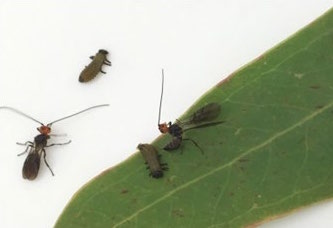PESTS AND DISEASES OF FORESTRY IN NEW ZEALAND
New potential biological control agent arrives in containment
Scion is the leading provider of forest-related knowledge in New Zealand
Formerly known as the Forest Research Institute, Scion has been a leader in research relating to forest health for over 50 years. The Rotorua-based Crown Research Institute continues to provide science that will protect all forests from damage caused by insect pests, pathogens and weeds. The information presented below arises from these research activities.
From Forest Health News 253, January/February 2015.

In December, Forest Protection entomologists received an exciting present: a live shipment of the “new to New Zealand” organism, Eadya paropsidis. Farm Forester Dean Satchell worked alongside Geoff Allen and Vin Patel from the University of Tasmania and hunted for Eadya in three Eucalyptus nitens plantations in Tasmania. They were successful in catching and importing 75 live female parasitic wasps into Scion’s Containment Facility. Eadya paropsidis is a 10 mm-long black braconid wasp with a bright orange head. This parasitoid is being considered for biological control of the eucalyptus tortoise beetle Paropsis charybdis in New Zealand, due to the damage this pest continues to wreak upon eucalypts, particularly E. nitens, along with other valued species such as E. bosistoana and E. quadrangulata. While some growers may choose to suffer the reduced growth of repeatedly damaged trees, large plantation owners often manage the pest with aerial pesticide applications.
Research on E. paropsidis has revealed this parasitoid specifically hunts on eucalypts foliage for tortoise beetle larvae within the genera Paropsis and Paropsisterna (Coleoptera: Chrysomelidae). Adult wasps sting young larvae and lay their eggs inside them (see photo below). Any larval life stage can be attacked, but the wasp is most successful attacking second instar larvae.
The parasitoid larva develops to maturity within the body of each host larva, which takes about 20 days, killing the host in the process. It then bursts out and pupates within the soil. After hibernating as a pupa for the rest of the year the resultant adult emerges the following spring.

The entomology team working in Scion’s containment facility now have about 1200 P. charybdis larvae that are producing parasitoid pupae. The next challenge will be to try and induce the new generation of parasitoids to emerge from hibernation in spring. They will attempt to trick the E. paropsidis into thinking the high security laboratory they are safely locked within, is actually the outdoors by simulating winter conditions. If successful, then next summer assessing its host specificity against a range of New Zealand native and beneficial beetles can begin. Safety testing is the key component of any biological control project, and only the safest of new organisms will ever be approved by the EPA (Environmental Protection Authority) for release. This project has been funded through a Sustainable Farming Fund grant, Scion MBIE Core Funding, the NZ Farm Forestry Association, South Wood Export Ltd, Future Forests Research Diversified Species, Carter Holt Harvey, and the Forest Owners Association. The project team are waiting nervously to find out if an SFF bid to support this project will be successful.
Toni Withers
This information is intended for general interest only. It is not intended to be a substitute for specific specialist advice on any matter and should not be relied on for that purpose. Scion will not be liable for any direct, indirect, incidental, special, consequential or exemplary damages, loss of profits, or any other intangible losses that result from using the information provided on this site.
(Scion is the trading name of the New Zealand Forest Research Institute Limited.)



